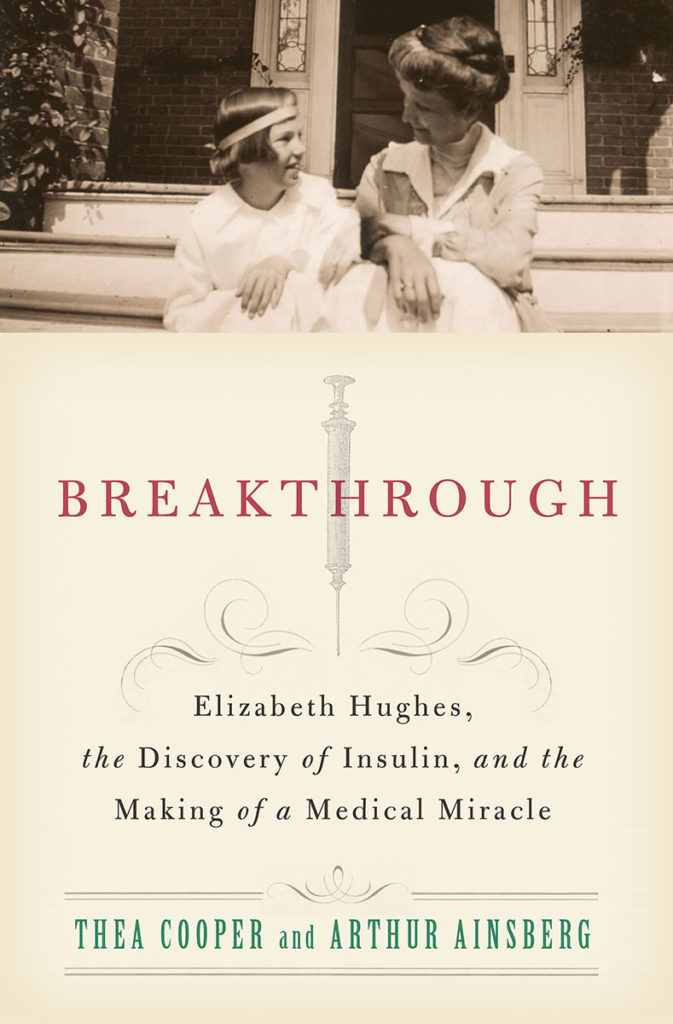Breakthrough: Elizabeth Hughes, the Discovery of Insulin, and the Making of a Medical Miracle
It was 1921 and the only way to prolong the life of a child with Type 1 diabetes was to starve her – literally. Fifteen-year-old Elizabeth Hughes, daughter of American politician and Supreme Court Justice Charles Evans Hughes weighed just 48 pounds when Canadian researchers Frederick Banting and Charles Best discovered the miracle drug that would save her and millions of others.
Arthur Ainsberg tells why he picked this story to write, in collaboration with Thea Cooper. “At the end of 2001, I was 54 and working at a large hedge fund that was not doing well. They offered to buy out my contract and I had to decide. Do I want to take on another hedge fund or do I want to step back a little bit from the world of business full time and do things that I had never before had a chance to do?
“I decided to make a bucket list. I took out a blank piece of paper and I wrote down everything I want to do for the rest of my life. I wrote down all the places in the world I wanted to go. I wrote down that I wanted to visit every state in the Union. I wanted to visit every presidential library in the United States. I wanted to visit every baseball stadium in America. And at the bottom of the list, I wanted to write a book.”
But what book? He wanted to write non-fiction and to focus on a story that had not been told before. After nearly two years of searching, on March 16, 2003, he was taking a break from his travels, “I’m sitting at home. It’s a Sunday. It’s a snowy New York day. I’m sitting in my den and I’m reading the Sunday New York Times magazine. I read this four-page story about the discovery of insulin, about this little girl who’s diagnosed with an incurable disease and she’s put on a starvation diet and after 37 months on a starvation diet she’s 15 years old and weighs 48 pounds. And then insulin is discovered. She’s the daughter of a very famous American politician and she’s able to get a spot in the trials in Toronto. She becomes the most famous patient of the discoverers of insulin. And she lived.
“I’m sitting in my den and I’m literally crying, hysterically crying.
“Why am I crying? Number one, because I thought I had my book. Number two, her story is my story. When I was 28 I was diagnosed with an incurable disease and right around the time that I was diagnosed they started finding some cures. I’m one of the early survivors of Hodgkin’s disease.
Ainsberg worked on the book for the next seven years, financing all of the research and travel himself. He brought in a writing partner and a research assistant. The manuscript was edited several times. Finally they auctioned the book. It was purchased by St. Martin’s in America and Cambridge in Canada.
“Not only that,” he says, “it was the lead book for St. Martin’s in the fall 2010 catalog and became a top-10 book in science and medicine on the New York Times list. It was also the source for an exhibit at the New York Historical Society.”
Ainsberg continues to lecture on the subject to audiences ranging from parents of children with Type I diabetes, who bring copies of the book for him to sign, to first-year medical students.
He says that this project has brought him immense satisfaction, not only because of how well the book has been received but also because “I’ve told an extraordinary story about extraordinary people. And about an extraordinary discovery and how the discovery of insulin has changed the world for going on a hundred years now.”


